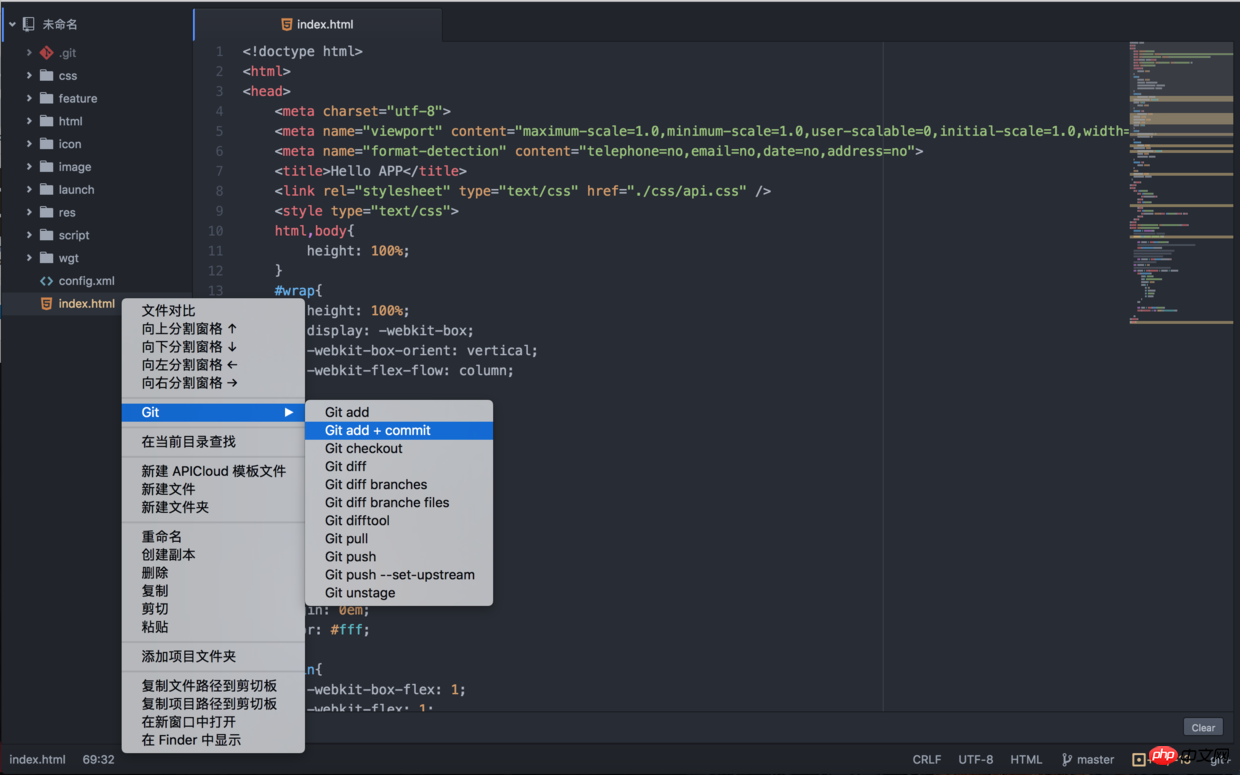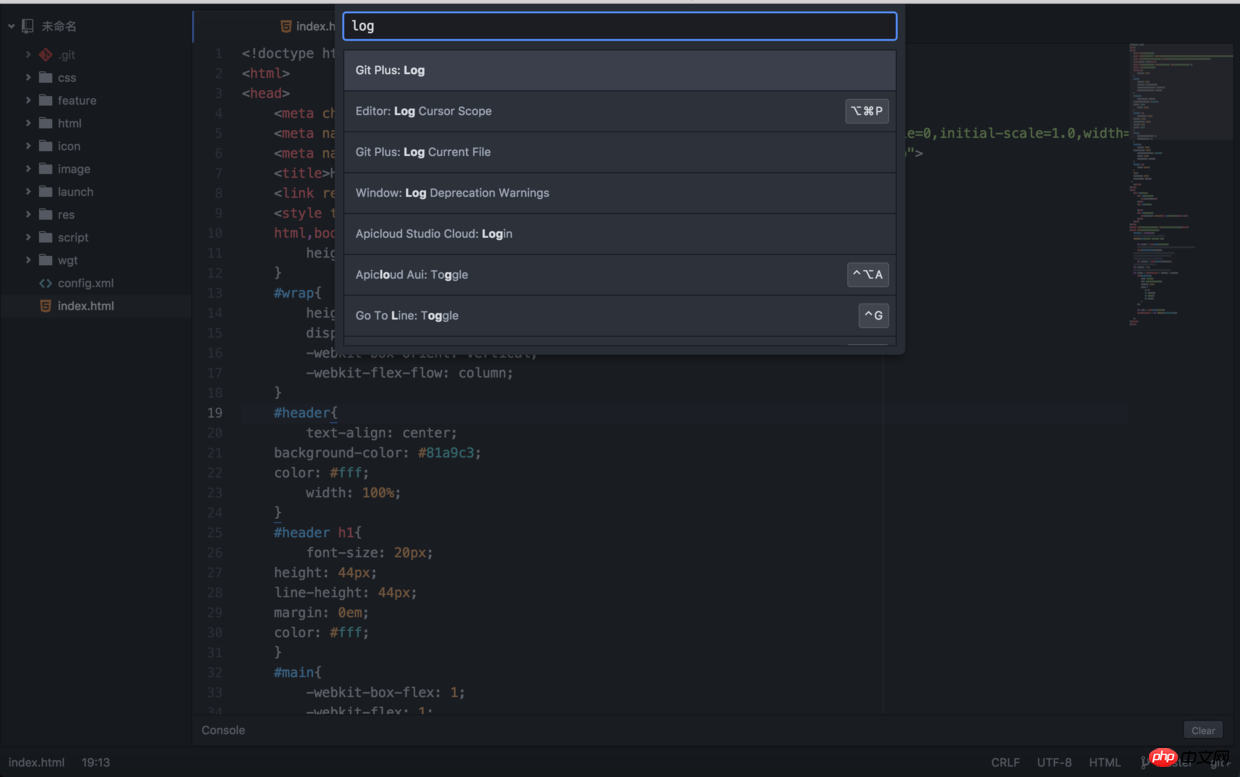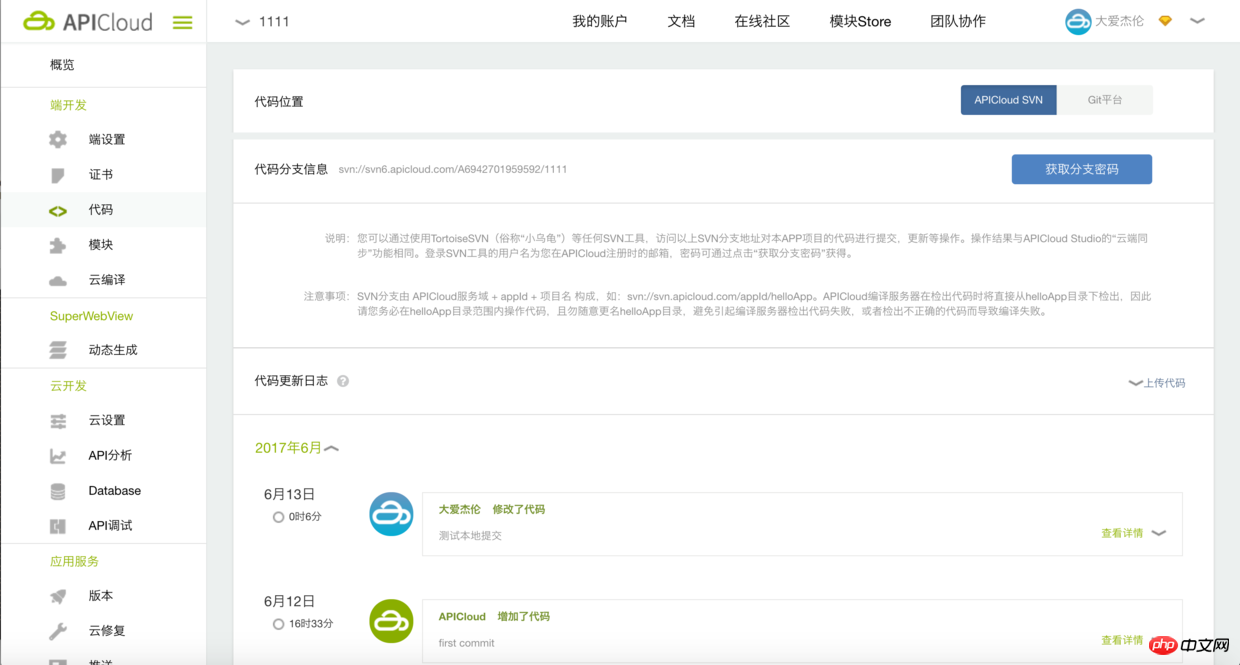APICloud Studio 2 tutorial using GIT-SVN technology
Changes in client code management tools: from SVN to GIT
As of now, the new version of APICloud Studio 2 is still in the public beta period. The code management client of APICloud Studio 2 has been changed from SVN to GIT. Company The code server is still an SVN server, and the front end uses GIT as the client. Some children must have guessed it - APICloud Studio 2 uses GIT-SVN technology to manage code.
This important feature cannot be I think it has become a major shortcoming of APICloud Studio 2. Almost every day, people ask questions like "Why does submitting to the code have no effect?" on the forum. We try to answer it every day on the forum, QQ, or through email. Developers have such questions about code submission. When they find problems, they mainly focus on their daily usage habits of code management tools. People who have experience in using GIT can easily get started after basically reading the documentation or simple tips; More developers who use SVN to manage code, although they can finally submit the code to the APICloud cloud, may still not really understand: Why do I have to make a local submission before synchronizing the code to the cloud.
Use How "difficult" is it to submit code in APICloud Studio 2?
Right-click a modified file or folder and select Git -> Git add + commit

In the new input box that appears at the bottom, enter a description to record what has been modified, the motivation for the modification, etc., then press ctrl/cmd + s to save



 ##Right-click cloud compilation--> Code, view code submission record
##Right-click cloud compilation--> Code, view code submission record
APICloud Studio2 integrates various functions of the cloud. We can directly right-click the project and enter its corresponding cloud interface. At this time we see that we just The modifications have been synchronized to the cloud.
 Isn’t it very convenient and amazing? You can actually use GIT to manage SVN code. Feelings about GIT-SVN technology If you are interested, why not search it quickly?!
Isn’t it very convenient and amazing? You can actually use GIT to manage SVN code. Feelings about GIT-SVN technology If you are interested, why not search it quickly?!
Why not continue to use SVN as the default code management tool of APICloud Studio 2?
First of all, it needs to be explained: The code management function is just One of the basic functions provided by APICloud Studio2, and there is no restriction that you must use APICloud Studio2 to manage code before you can continue to use other functions of APICloud Studio2. If you still have a soft spot for SVN, or the project is too busy these days, you can use various A third-party code management tool to manage your APICloud application. The SVN address and password can be obtained from the cloud console.
 Then, there is the core code management of APICloud Studio2 Why was the tool changed to GIT? Of course because it is more efficient and has more potential! In this way, it may be a bit abstract, let’s give a specific example. You can take a look at 2.1.4. There is a very important but not very eye-catching one. Update: The local code time machine function is launched, which supports manual backup and automatic backup of local uncommitted code when synchronizing with the cloud. It is based on the stash command of GIT. It can be done as long as your local .git directory is not artificially destroyed. Once the uncommitted code is lost due to some accident, you can use the "local code time machine" function to retrieve it. Of course, you don't have to worry about the size of the .git directory, because local backup is not a simple zip compression. Interested You can study the git stash command carefully.
Then, there is the core code management of APICloud Studio2 Why was the tool changed to GIT? Of course because it is more efficient and has more potential! In this way, it may be a bit abstract, let’s give a specific example. You can take a look at 2.1.4. There is a very important but not very eye-catching one. Update: The local code time machine function is launched, which supports manual backup and automatic backup of local uncommitted code when synchronizing with the cloud. It is based on the stash command of GIT. It can be done as long as your local .git directory is not artificially destroyed. Once the uncommitted code is lost due to some accident, you can use the "local code time machine" function to retrieve it. Of course, you don't have to worry about the size of the .git directory, because local backup is not a simple zip compression. Interested You can study the git stash command carefully.
Summary
GIT is so easy to use, why do some people still don’t know how to use it to submit code? Of course it is the difference in personal code management tool usage habits. However, I can tell you responsibly that familiar Downloading GIT will not only help you better develop APICloud applications, but also help you learn and work in all aspects in the future. Try to look at the world from a different angle and you will find new differences~
The above is the detailed content of APICloud Studio 2 tutorial using GIT-SVN technology. For more information, please follow other related articles on the PHP Chinese website!

Hot AI Tools

Undresser.AI Undress
AI-powered app for creating realistic nude photos

AI Clothes Remover
Online AI tool for removing clothes from photos.

Undress AI Tool
Undress images for free

Clothoff.io
AI clothes remover

AI Hentai Generator
Generate AI Hentai for free.

Hot Article

Hot Tools

Notepad++7.3.1
Easy-to-use and free code editor

SublimeText3 Chinese version
Chinese version, very easy to use

Zend Studio 13.0.1
Powerful PHP integrated development environment

Dreamweaver CS6
Visual web development tools

SublimeText3 Mac version
God-level code editing software (SublimeText3)

Hot Topics
 Is the conversion speed fast when converting XML to PDF on mobile phone?
Apr 02, 2025 pm 10:09 PM
Is the conversion speed fast when converting XML to PDF on mobile phone?
Apr 02, 2025 pm 10:09 PM
The speed of mobile XML to PDF depends on the following factors: the complexity of XML structure. Mobile hardware configuration conversion method (library, algorithm) code quality optimization methods (select efficient libraries, optimize algorithms, cache data, and utilize multi-threading). Overall, there is no absolute answer and it needs to be optimized according to the specific situation.
 In Go, why does printing strings with Println and string() functions have different effects?
Apr 02, 2025 pm 02:03 PM
In Go, why does printing strings with Println and string() functions have different effects?
Apr 02, 2025 pm 02:03 PM
The difference between string printing in Go language: The difference in the effect of using Println and string() functions is in Go...
 Why is it necessary to pass pointers when using Go and viper libraries?
Apr 02, 2025 pm 04:00 PM
Why is it necessary to pass pointers when using Go and viper libraries?
Apr 02, 2025 pm 04:00 PM
Go pointer syntax and addressing problems in the use of viper library When programming in Go language, it is crucial to understand the syntax and usage of pointers, especially in...
 Why do all values become the last element when using for range in Go language to traverse slices and store maps?
Apr 02, 2025 pm 04:09 PM
Why do all values become the last element when using for range in Go language to traverse slices and store maps?
Apr 02, 2025 pm 04:09 PM
Why does map iteration in Go cause all values to become the last element? In Go language, when faced with some interview questions, you often encounter maps...
 xml online formatting
Apr 02, 2025 pm 10:06 PM
xml online formatting
Apr 02, 2025 pm 10:06 PM
XML Online Format Tools automatically organizes messy XML code into easy-to-read and maintain formats. By parsing the syntax tree of XML and applying formatting rules, these tools optimize the structure of the code, enhancing its maintainability and teamwork efficiency.
 Go language slice: Why does it not report an error when single-element slice index 1 intercept?
Apr 02, 2025 pm 02:24 PM
Go language slice: Why does it not report an error when single-element slice index 1 intercept?
Apr 02, 2025 pm 02:24 PM
Go language slice index: Why does a single-element slice intercept from index 1 without an error? In Go language, slices are a flexible data structure that can refer to the bottom...
 Does XML modification require programming?
Apr 02, 2025 pm 06:51 PM
Does XML modification require programming?
Apr 02, 2025 pm 06:51 PM
Modifying XML content requires programming, because it requires accurate finding of the target nodes to add, delete, modify and check. The programming language has corresponding libraries to process XML and provides APIs to perform safe, efficient and controllable operations like operating databases.
 What is the priority of C language !x?
Apr 03, 2025 pm 02:06 PM
What is the priority of C language !x?
Apr 03, 2025 pm 02:06 PM
The logical non-operator (!) has the priority next to parentheses, which means that in expressions, it will precede most other operators. Understanding priority not only requires rote memorization, but more importantly, understanding the logic and potential pitfalls behind it to avoid undetectable errors in complex expressions. Adding brackets can clarify expression intent, improve code clarity and maintainability, and prevent unexpected behavior.






